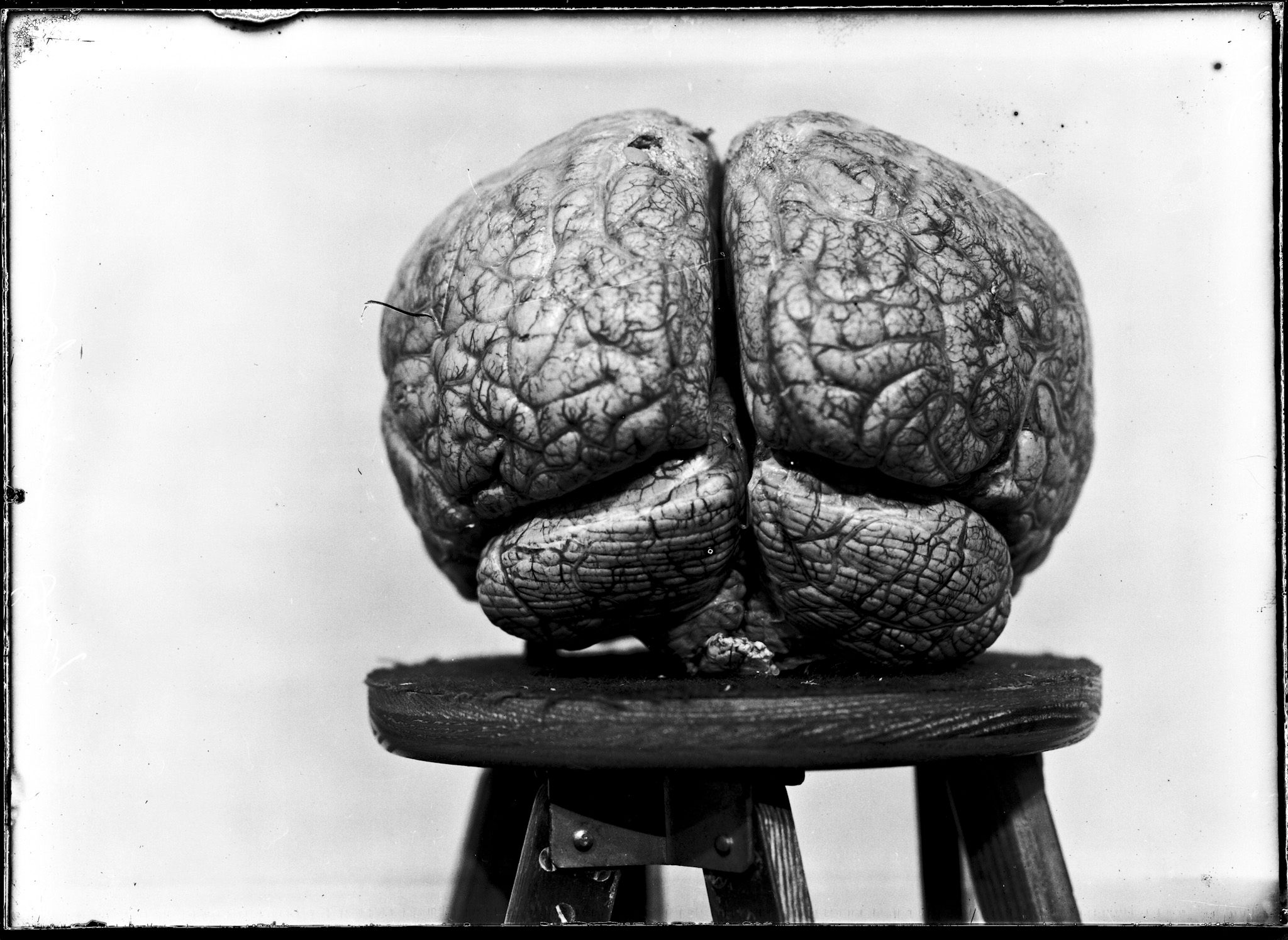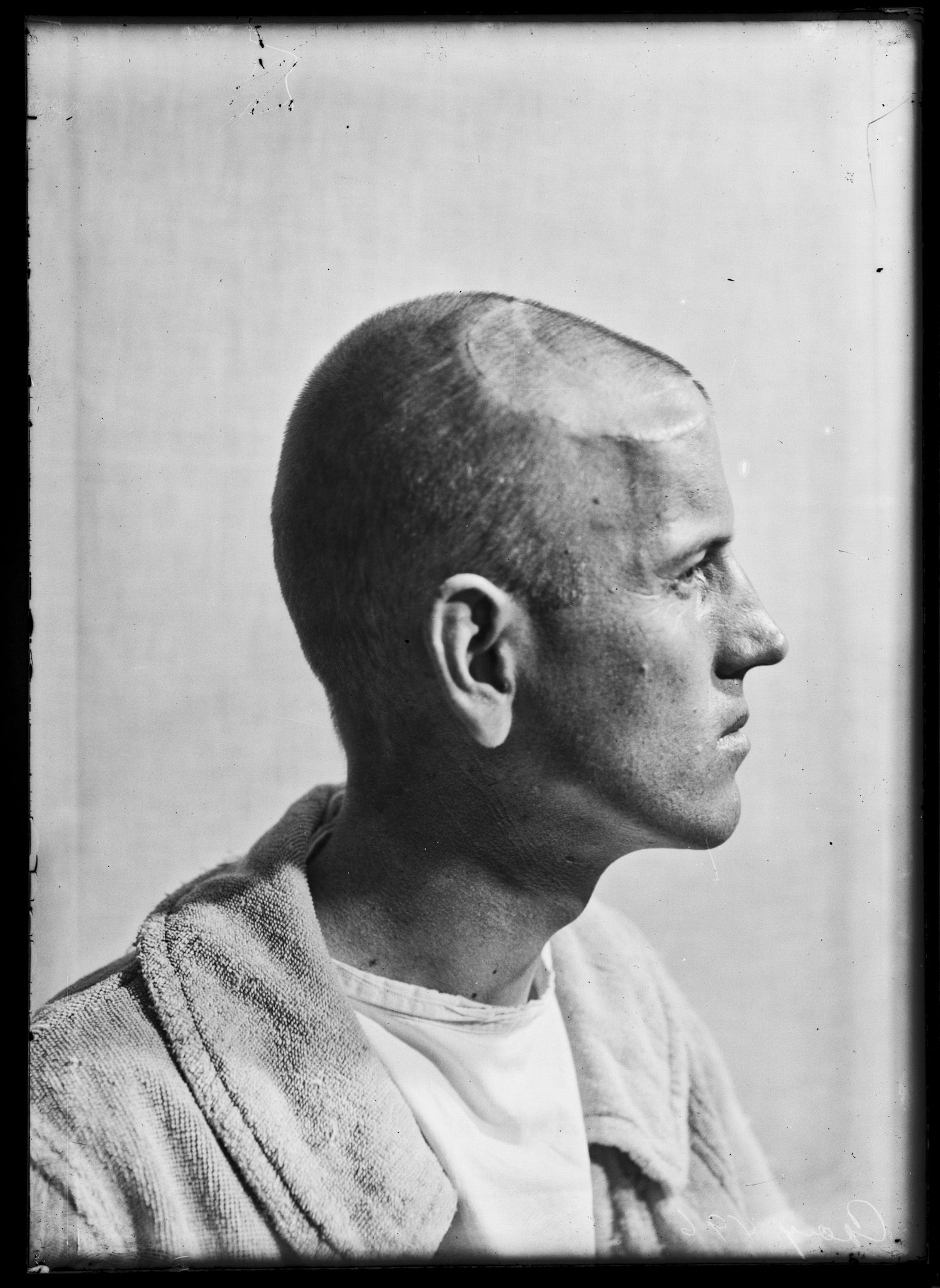See These Stunning Photos Of Brain Surgery’s Earliest Patients

(Photo: Cushing Tumor Registry - Cushing/Whitney Medical Library/Yale University)
For more than three decades, two amazing relics of medical history lay rotting underneath a Yale University dorm—Dr. Harvey Cushing’s collection of brains, and his collection of patient photography. The former has been given its own exhibition space in Harvey Cushing/John Hay Whitney Medical Library, Yale University, open to the public since 2010. About 500 brains sit in the $1.4 million-dollar Cushing Center, carefully preserved in the leaden glass jars in which they arrived.
The 10,000 glass plates, though, have only just begun their journey to public consumption. Its contents are finally beginning to be seen—the pictures in this story have only been digitized in the past year and they are published here for the first time. The images are staggering.
Babies with distended skulls sit on a mother’s knee. Neat scars form patterns on patient skulls, like farmland seen from an airplane window. Often, the photos are taken in profile, or are a close-up of hands. Some of the most bewitching pictures involve a patient staring at the camera head-on, with a directness rare in today’s selfie-strewn world.
“They just keep revealing themselves,” says Terry Dagradi, Cushing Center Coordinator, “They are amazing not because they were shot to be amazing. They were shot to be documentary, shot as the history of neuroscience was being born.”
The path of both the brains and the patient photos is circuitous. Its formal title is the Cushing Tumor Registry, and it represents the work of Cushing from 1900 to 1933. The doctor, who was born in Cleveland in 1869, graduated from Yale and then spent his professional career at places like Johns Hopkins and Harvard—a career that profoundly shapes our understanding of the brain. Cushing was a pioneer in neuroscience, with tumors being of particular interest to him. (He also won a Pulitzer Prize in 1926 for a biography of his mentor, Dr. William Osler, among other accomplishments including diagnosing the disease named after him, Cushing disease.) Beginning in 1902, he began saving specimens of his work along with immense amounts of documentation: By the time his registry arrived (with the doctor) at Yale in 1934, Cushing had collected more than 2,200 case studies, including brain specimens, tumor specimens and 15,000 photo negatives, both on film and glass plate.
According to Dagradi, it was a woman, Dr. Louise Eisenhardt, who first looked after the collection. “It had a place of importance and research,” says Dagradi, “She was one of the masterminds of how the collection was put together.” After her death in 1967, as better scanning technology began to displace the need for physical specimens, “it turned into an inherited problem.”
So Cushing’s brains, as they were called, were moved into the basement of a Yale medical school dorm in 1979. They weren’t lost, exactly, but they were kept as a curiosity. According to the collection’s website, students would enter through a crawl space and then sign a whiteboard to be members of the “Brain Society.” It wasn’t until the 1990s that a student named Christopher John Wahl took an interest in the collection, and funding was found to exhume it from the basement.
The brains had been a known commodity, but the photography was a surprise. There were mostly glass plate negatives, but some film was found as well. Thirty years of dormitory storage took its toll. “It was a wet basement that would get really hot and the plates were stacked on top of each other,” Dagradi says.” The film negatives did not stand up to time, sadly.

Dagradi calls this brain-on-a-wooden-stool picture “surreal.” (Photo: Cushing Tumor Registry - Cushing/Whitney Medical Library/Yale University)
But around 10,000 black-and-white posed photographs of patients in varying states of treatment survived. “The photographs revealed this whole other aspect to the collection,” says Dagradi, who was a photographer working for Yale when the mid-’90s project began,” I got obsessed with the images.” It’s not hard to see why: While it can be hard to look at some pictures, of say, children with swollen faces, the images capture people at their most vulnerable and human. There is something incredibly contemporary about the poses.
Dagradi says that there is no way to know who took the pictures. They were snapped over a 30-year period and reflect photographers of varying skill, resulting in over and under exposed images. But while these pictures might look like Diane Arbus outtakes, they were done purely for documentary purposes. “They couldn’t see into the body the way that we can now, so photos could be critical to diagnosing patients,” says Dagradi. Of particular diagnostic value for Dr. Cushing were faces and hands: veins being clogged or fingernail defects were strong evidence of certain diseases.
Over a decade into the process of unboxing, recording, digitizing and cataloging the pictures, Dagradi says Dr. Cushing’s collection still holds mysteries. Who were the patients? Who were the photographers? What is the story behind a man’s Frankenstein-like scars on his head, or a young girl’s tumorous forehead? Of the thousands of images, she estimates that only a quarter, around 2,500, have been catalogued completely, a laborious process that involves matching the case number on the photo to Dr. Cushing’s specimens and other written documentation. (At one time, Dagradi says, the files were perfectly laid out but then archivists finally pulled the lot from the basement, there was “no way of figuring out how to order them.”) In the future, all of this information will be in a searchable database.
Names are difficult to confirm and Dagradi says that even though it is unlikely that any of the people pictured are still alive, medical ethics prohibit her from releasing any identifying information.
So, every day, Dagradi and her team look at more of Dr. Cushing’s patients. Medical grotesqueries don’t shock her anymore but some pictures still catch her off-guard. “There are these photos of children that have some kind of a distressed condition, yet there’s an attempt to smile, a kind of lopsided smile. They look so fragile,” she says, “There’s this sense that this might be the only photo ever taken of them—the girl with the perfect satin bow, or maybe a kid wearing a threadbare piece of fabric, the incidental nurse peeking around a corner, or an orderly, holding someone up who is barely alive.” The images might be grim, capturing people at the end of their lives, but the intent of the photographer is hopeful. If Dr. Cushing could understand that one malady better through these patient images, maybe then someone else could be saved.
The Cushing Center is part of the Obscura Day 2015 schedule. To get more information and tickets, go here.

(Photo: Cushing Tumor Registry - Cushing/Whitney Medical Library/Yale University)

(Photo: Cushing Tumor Registry - Cushing/Whitney Medical Library/Yale University)

(Photo: Cushing Tumor Registry - Cushing/Whitney Medical Library/Yale University)

(Photo: Cushing Tumor Registry - Cushing/Whitney Medical Library/Yale University)

(Photo: Cushing Tumor Registry - Cushing/Whitney Medical Library/Yale University)

(Photo: Cushing Tumor Registry - Cushing/Whitney Medical Library/Yale University)

(Photo: Cushing Tumor Registry - Cushing/Whitney Medical Library/Yale University)

(Photo: Cushing Tumor Registry - Cushing/Whitney Medical Library/Yale University)
Updated, 5/19: An earlier version of this story incorrectly stated that Dr. Cushing won the Pulitzer Prize in 1928. He actually did in 1926. We regret the error.







Follow us on Twitter to get the latest on the world's hidden wonders.
Like us on Facebook to get the latest on the world's hidden wonders.
Follow us on Twitter Like us on Facebook